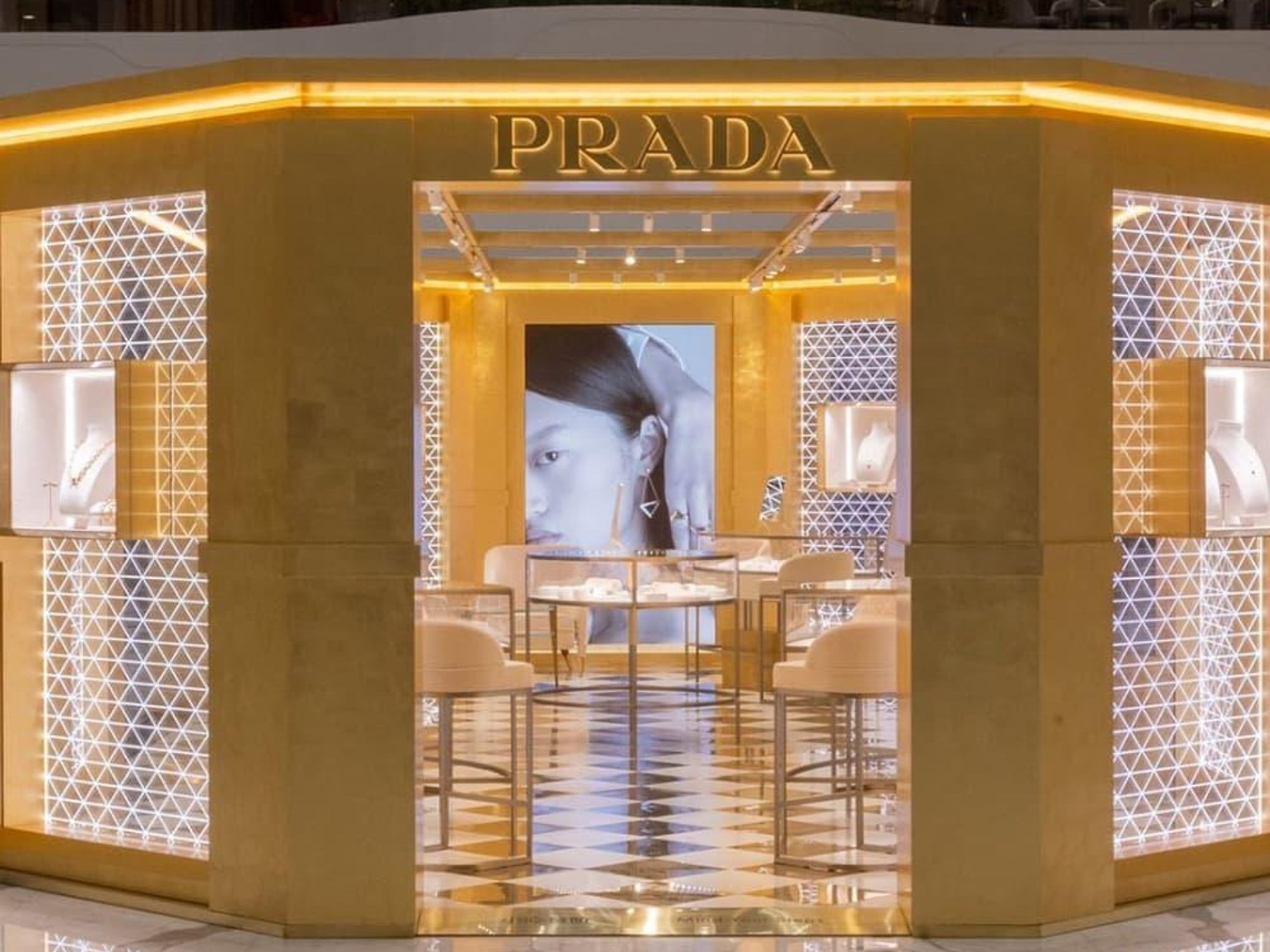Prada is an Italian luxury fashion house founded in 1913 in Milan by Mario Prada. It specializes in leather handbags, travel accessories, shoes, ready-to-wear, and other fashion accessories. Prada licenses its name and branding to Luxottica for eyewear and L’Oréal for fragrances. In this article, we’ll delve into the Marketing Strategies and Marketing Mix of Italian Ultra-luxury fashion house, Prada.
Prada is known for its high-quality, minimalist designs. The brand’s signature style is characterized by clean lines, simple shapes, and muted colors. Prada’s clothes and accessories are often made from high-quality materials, such as leather, cashmere, and silk.
Prada has been a major influence on the fashion world since its inception. The brand’s designs have been worn by celebrities and fashion icons alike. Prada has also been credited with popularizing the “athleisure” trend, which combines elements of athletic wear with more formal clothing.
In recent years, Prada has expanded its reach beyond fashion. The brand has opened a number of hotels and restaurants, and it has also launched a line of home furnishings. Prada is also a major sponsor of art and culture, and it has donated millions of dollars to various charitable causes.
Today, Prada is a global fashion powerhouse. The brand has over 610 stores in over 70 countries. Prada’s products are also available online. The brand’s annual revenue is estimated to be over €4.2 billion.
Prada is still family-owned, and Miuccia Prada remains the creative director of the company. She is one of the most influential women in the fashion world, and she is credited with helping to make Prada one of the most successful luxury fashion brands in the world.
The Founding History of Prada: From Leather Goods to Global Fashion Powerhouse
Prada, one of the world’s most prestigious and influential luxury fashion houses, has a rich and storied founding history that dates back over a century.
Prada was founded in 1913 by Mario Prada in Milan, Italy. Initially, the company operated as a small luxury goods store called “Fratelli Prada” (Prada Brothers). The store primarily offered leather goods, including handbags, luggage, and accessories, catering to an elite clientele.
In the late 1970s, the fashion industry underwent significant changes, and the demand for luxury goods evolved. In response, Mario’s granddaughter, Miuccia Prada, took the reins of the company in 1978. Miuccia, a visionary designer with a Ph.D. in political science, brought a fresh perspective to Prada.
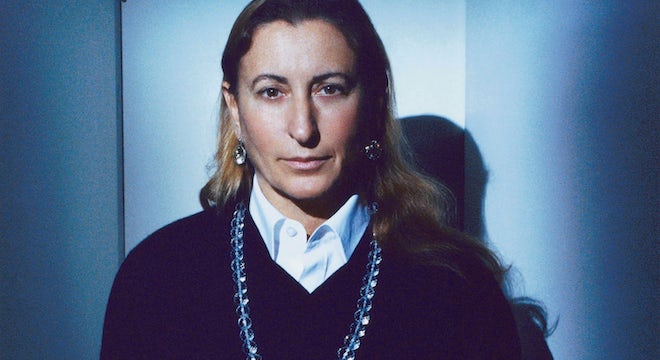
Under Miuccia’s guidance, Prada shifted its focus to women’s ready-to-wear fashion. She introduced the first line of luxury nylon handbags in 1979, showcasing her innovative approach to materials and design. The lightweight, durable nylon bags, adorned with the now-famous Prada logo, became an instant hit and a symbol of the brand’s modern and minimalist aesthetic.
Throughout the 1980s and 1990s, Prada cemented its reputation as a leading fashion house, known for its understated elegance and attention to detail. Miuccia’s designs resonated with women who sought sophisticated yet unconventional pieces. Prada’s collections were characterized by clean lines, luxurious fabrics, and a blend of classic and avant-garde elements.
The brand’s iconic black nylon backpack, introduced in 1984, became an iconic accessory and a symbol of Prada’s distinctive blend of practicality and high fashion. Prada’s popularity surged among celebrities, fashion influencers, and trendsetters, solidifying its status as a fashion icon.
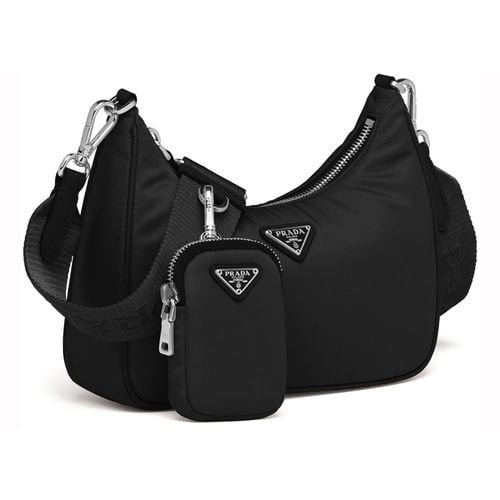
As Prada’s reputation continued to grow, the brand expanded its product offerings and opened flagship stores in prominent fashion capitals worldwide, including New York, London, Paris, and Tokyo. Prada’s retail presence further elevated its global appeal and accessibility.
In the 1990s, the Prada Group acquired other luxury fashion brands like Jil Sander and Helmut Lang, diversifying its portfolio and establishing itself as a major player in the luxury fashion industry.
Prada’s runway shows became highly anticipated events in the fashion world, setting trends and shaping the direction of the industry. Miuccia’s innovative and thought-provoking collections challenged conventional ideas of beauty and femininity. Prada’s shows were often a blend of art, fashion, and social commentary, earning critical acclaim and admiration from fashion critics and enthusiasts alike.
In the early 2000s, Prada embraced technology and innovation, launching its official website and online store. The brand’s digital presence enabled it to reach a wider audience and cater to the growing demand for e-commerce.
Additionally, Prada expanded into other product categories, including footwear, eyewear, fragrances, and ready-to-wear menswear. The brand’s commitment to quality craftsmanship and sophisticated designs remained consistent across all product lines.
In recent years, Prada, like many other fashion brands, has emphasized its commitment to sustainability and social responsibility. The brand has taken steps to reduce its environmental impact and promote responsible sourcing and manufacturing practices.
Prada’s founding history is a testament to the vision and ingenuity of its founders and the transformative leadership of Miuccia Prada. From its origins as a small leather goods shop in Milan to becoming a global fashion powerhouse, Prada’s journey has been characterized by innovation, elegance, and a relentless pursuit of excellence. With its unique blend of tradition and modernity, Prada continues to shape the fashion industry, setting trends and inspiring fashion enthusiasts worldwide.
Marketing Strategies of Prada: Elevating Luxury Fashion
Prada, known for its timeless elegance and distinctive designs, employs a combination of innovative and traditional marketing strategies to maintain its position as a leading luxury fashion brand. Let’s explore the key marketing strategies that have contributed to Prada’s success:
Brand Image and Positioning:
Prada’s brand image and positioning strategy plays a crucial role in communicating what the brand represents and differentiating it from competitors within the luxury fashion industry. Here are more details about how Prada positions itself through its brand image:
Elevated Luxury Aesthetic:
At the heart of Prada’s brand identity lies a commitment to creating beautifully designed garments and accessories using only the finest materials and craftsmanship techniques. Each piece embodies a refined yet understated elegance that appeals to discerning consumers seeking exceptional quality and timeless style. From sleek handbags and classic pumps to tailored suits and statement outerwear, every item exudes prestige and exclusivity.
Iconic Logo and Signature Colors:
Prada’s logo features a simple yet recognizable font styling the brand name in capital letters against a white background. The black and blue stripes running diagonally across the label have become synonymous with the brand’s heritage and add a touch of sporty chic to various pieces. The use of these colors also helps distinguish Prada from competitors and creates instant recognition among consumers.
Artistic Collaborations and Cultural Participation:
Prada regularly engages in creative projects beyond the world of fashion, including collaborations with prominent artists, architects, filmmakers, and musicians. For instance, the brand partnered with Tom Holland to produce an advertisment featuring Prada’s Summer/Spring 2022 collection. Such cultural endeavors not only elevate the brand’s image but also demonstrate its dedication to inspiring creativity and pushing boundaries.
Exclusive Retail Environment:
Prada stores are designed to provide an intimate and luxurious shopping experience. The minimalist interiors incorporate polished marble flooring, sleek chrome accents, and soft lighting to create an ambiance that complements the brand’s elegant designs. To deliver personalized service, sales associates at Prada boutiques receive extensive training to understand the nuances of each product line and offer expert advice to customers. They strive to build relationships with clients and ensure they feel valued throughout their shopping journey. This level of customer care aligns with Prada’s focus on providing a premium retail environment where shoppers can fully immerse themselves in the brand culture.
Design Innovation and Creative Direction:
Prada has consistently been recognized for setting trends rather than simply following them. Miuccia Prada, the brand’s creative director, often pushes the boundaries of traditional fashion norms and introduces unexpected silhouettes, fabrics, and color palettes into her collections. Her bold vision has earned Prada widespread critical acclaim and helped shape the future of high-end fashion.
Every element of a Prada creation receives meticulous attention to detail, ensuring that even small finishing touches contribute to the overall impact of the final product. Whether it be intricate embroidery patterns, subtle draping effects, or unique hardware components, Prada’s commitment to excellence reflects its unwavering pursuit of beauty and quality.
Prada frequently experiments with vibrant hues and nonconformist color combinations that challenge conventional fashion wisdom. These risky choices often pay off, generating buzz and sparking conversations about the brand’s forward-thinking approach to dressing.
Prada runway shows are renowned for their impressive production values, showcasing cutting-edge technology and immersive sets. From LED screens to interactive projections, the brand’s presentations blend artistry with technological innovation, creating memorable moments that resonate long after the event ends. These spectacles reinforce Prada’s reputation as a trailblazer in both fashion and experiential marketing.
Digital and Social Media Presence:
Prada leverages digital and social media presence as an essential component of its marketing strategy. Here’s a detailed breakdown of how the brand utilizes these platforms:
Engaging Website Experience:
Prada’s website serves as a virtual flagship store where visitors can explore current collections, discover behind-the-scenes content, and shop online. The site is designed to provide an engaging user experience that mirrors the physical shopping journey while emphasizing ease of use and mobile optimization. Visitors can browse products by category or search for specific items using filters such as size, color, or price range.
Interactive Online Lookbooks:
Prada presents its collections through interactive online lookbooks that allow users to zoom in on details, view different angles, and click through to purchase options. These multimedia experiences enhance the customer’s understanding of the collection and increase engagement with the brand.
Regular Social Media Posts:
Prada maintains active profiles on popular social media channels like Instagram, Facebook, Twitter, TikTok, and WeChat. The brand shares regular updates featuring new arrivals, campaign imagery, backstage glimpses during fashion week, and insider views of events and parties. By posting consistently, Prada keeps followers engaged and informed without overwhelming them with promotional messages.
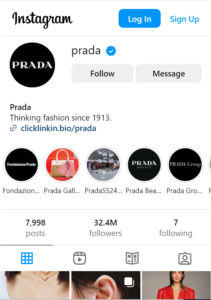
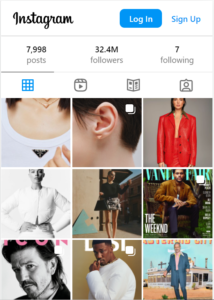
Exclusive Previews and Early Access:
To reward loyal customers and build excitement around new launches, Prada offers exclusive previews and early access to select groups. For instance, members of the brand’s online community might receive sneak peeks at forthcoming collections or have first dibs on limited edition drops. Such initiatives foster a sense of belonging within the Prada community and strengthen emotional connections between consumers and the brand.
Virtual Reality Experiences:
Prada has experimented with incorporating virtual reality (VR) elements into its marketing efforts. For example, it launched a VR film titled “The Human Race” during Milan Fashion Week in 2018. The project allowed viewers to immerse themselves in the world of Prada and feel part of the show.
Personalized Email Communications:
Prada sends targeted emails to customers based on their interests and purchases. These communications often include tailored recommendations, invitations to exclusive events, and updates on new arrivals. By providing personalized touchpoints, Prada builds stronger relationships with clients and increases sales conversions.
Iconic Advertising Campaigns:
Prada’s iconic advertising campaigns play a crucial role in elevating the brand image and connecting with customers. Here’s a deeper dive into this aspect of the company’s marketing approach:
Print Advertisements:
Prada regularly places print ads in top international publications such as Vogue, Harper’s Bazaar, Vanity Fair, and W Magazine. These visually stunning spreads feature the latest collections and highlight key pieces from each season. The ads aim to inspire readers and encourage them to visit stores or make online purchases.
Billboards and Outdoor Displays:
Prada also employs large-scale billboard installations and street-level displays in major cities globally. These eye-catching visuals grab attention and draw people towards the brand, helping establish its premium positioning in the fashion industry.
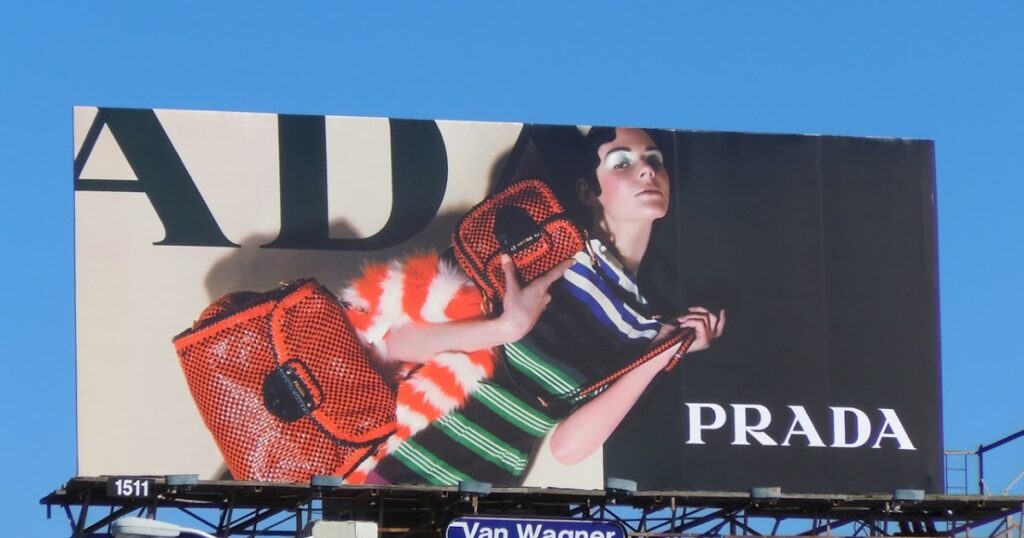
Collaborative Projects:
Prada teams up with renowned photographers, stylists, and creative directors to produce memorable campaigns that push boundaries and challenge conventional beauty standards. Working with visionaries like Steven Meisel, Inez van Lamsweerde & Vinoodh Matadin, and Willy Vanderperre ensures bold and thought-provoking images that resonate with audiences.
Limited Edition Product Launches:
Prada frequently introduces special editions or capsule collections that generate significant interest among collectors and enthusiasts. These exclusive offerings drive demand and fuel word-of-mouth promotion via social media and influential circles.
Global Events Attendance:
Prada participates in prominent fashion weeks, art fairs, and cultural happenings around the globe. Showcasing its latest creations at these events allows the brand to connect with diverse audiences and reinforce its reputation as a leader in luxury fashion innovation.
Guerrilla Marketing Techniques:
Prada occasionally uses unconventional tactics like flash mobs, pop-up stores, and surprise performances to disrupt daily routines and captivate passersby.
Digital Storytelling:
Prada creates engaging multimedia experiences through interactive microsites, immersive web films, and shoppable lookbooks. These digital narratives transport users into the world of Prada, allowing them to explore products, learn about design inspirations, and discover the stories behind each collection.
Brand Ambassadors:
Prada selects individuals who embody the brand values and appeal to specific demographics. Past ambassadors have included actors, musicians, artists, athletes, and other notable figures who reflect the brand’s sophisticated yet rebellious nature. Their influence extends beyond traditional celebrity endorsement deals by fostering meaningful connections between the brand and consumers.
Store Design and Retail Experience:
Prada’s physical retail spaces are designed with meticulous attention to detail, reflecting the brand’s sophisticated and minimalist aesthetic. The stores offer a luxurious and immersive shopping experience, reinforcing the brand’s image of exclusivity and elegance.
Prada’s flagship stores in fashion capitals like Milan, New York, Paris, and Tokyo serve as architectural landmarks, attracting fashion enthusiasts and tourists alike. The brand’s dedication to creating a unique and premium retail environment enhances the overall customer experience and reinforces its luxury positioning.
Minimalism Meets Luxury: Prada stores embody a sleek, modern aesthetic characterized by clean lines, muted colors, and ample use of lightweight materials such as glass and metal. This minimalist sensibility reflects the brand’s focus on simplicity and functionality while still communicating sophisticated luxury.
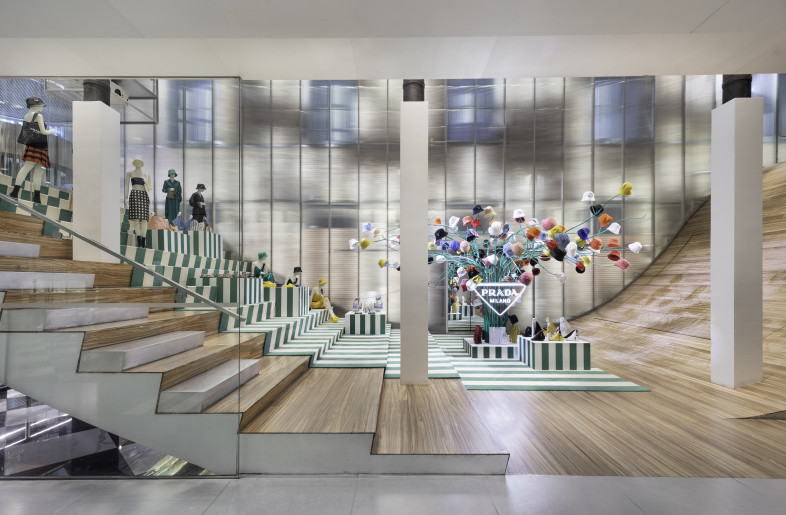
Iconic Elements: Key features like polished chrome accents, geometric shapes, and bold lettering distinguish Prada boutiques worldwide. These elements unify the brand’s visual language across locations and imbue each space with a cohesive ambiance that resonates with customers.
Immersive Atmosphere: Prada strives to create immersive environments that transport visitors to the world of the brand. For instance, the flagship Milan store boasts a dedicated room showcasing art installations and special exhibits related to the company’s history and cultural contributions. This type of experiential retail enhances the overall shopping journey and strengthens emotional ties between customers and the brand.
Personalization Options: Customizable services like monogramming and custom fittings further differentiate Prada’s retail experiences. These tailored touches underscore the brand’s dedication to individuality and encourage shoppers to invest in products that become uniquely their own.
Omnichannel Integration: Seamless integration between physical and digital channels ensures a consistent brand message and streamlined shopping process. Interactive screens, mobile point-of-sale systems, and other technologies facilitate seamless transitions between online browsing and in-store purchases, enhancing convenience and customer satisfaction.
Pop-Up Shops: Temporary pop-up stores have been used by Prada to introduce limited-time offerings or commemorate milestone events. These short-lived venues inject fresh energy into the brand’s retail landscape, generating buzz through novelty and exclusivity.
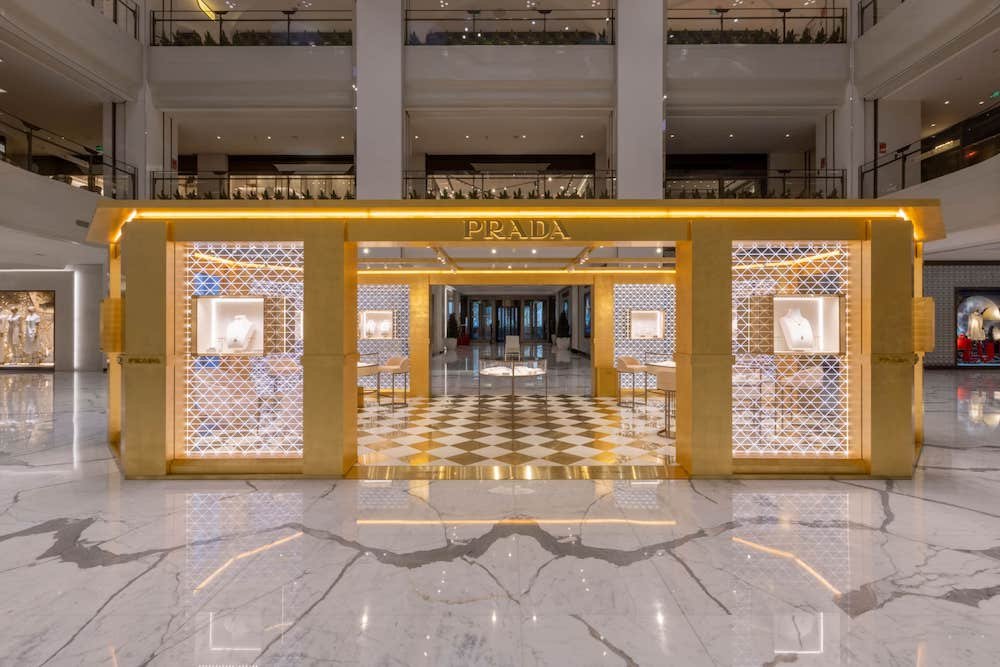
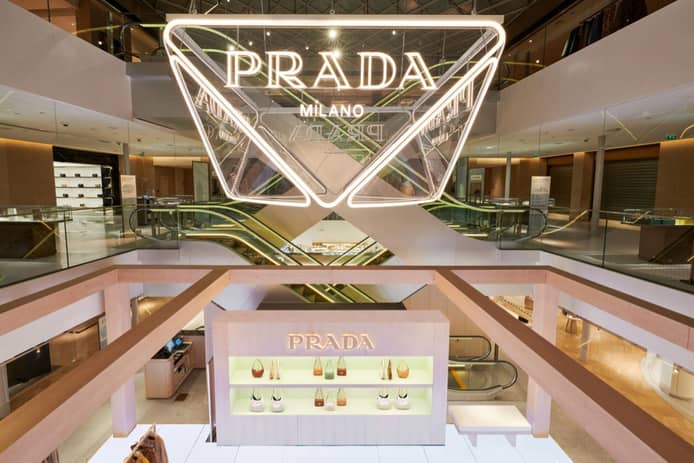
Collaborations and Limited Editions:
Prada strategically engages in collaborations with artists, designers, and creative talents from various fields. These partnerships often result in limited-edition collections, attracting collectors and fashion enthusiasts seeking exclusive and one-of-a-kind pieces.
Collaborations:
Artistic Partnerships: Prada has teamed up with various contemporary artists across different mediums (painting, sculpture, photography) to create one-off works inspired by the brand’s heritage and current collections. By partnering with boundary-pushing artists like Theaster Gates, Olga Polska, and John Baldessari, Prada showcases its appreciation for cutting-edge creativity and willingness to experiment outside the realm of fashion.
Fashion Collaborations: Prada has joined forces with fellow Italian powerhouse Fiat to develop a limited edition car featuring the label’s signature black nylon fabric. This collaboration blends two icons of Italian excellence and emphasizes their shared passion for quality craftsmanship and timeless design.
Fragrances: In addition to launching standalone perfumes under the Prada name, the brand has released scents developed in partnership with esteemed fragrance houses like Puig and LVMH. These alliances ensure access to expertise in the competitive fragrance market and expand Prada’s presence in the beauty sector.
Limited Editions:
Special Releases: Prada periodically offers exclusive items within existing lines or separate collections designed specifically for select markets or occasions. These limited editions often incorporate unique details, rare fabrics, or intricate embellishments that cater to discerning clients seeking truly exceptional pieces.
Collectible Items: To attract avid collectors and connoisseurs, Prada produces limited runs of highly coveted goods like handmade leather bags, exotic skin wallets, and crystal-embellished jewelry. These items not only command premium prices but also help build a sense of exclusivity and rarity around the brand.
Online Restocks: Prada occasionally restocks sold-out items on its website or releases new colorways or variants of popular pieces. While not strictly labeled “limited editions,” these online restocks allow Prada to capitalize on demand generated by social media buzz and customer word-of-mouth recommendations. They provide opportunities for interested buyers to acquire desired items without resorting to resellers or secondary markets where prices can skyrocket due to high demand and low supply.
Overall, Prada’s collaborations and limited editions serve multiple purposes. Firstly, they enable the brand to tap into diverse sources of inspiration and innovative ideas. Secondly, they generate excitement among loyal customers and capture the interest of potential ones by offering exclusive merchandise or unexpected twists on classic designs. Finally, these strategies reinforce Prada’s reputation for creativity, versatility, and ability to adapt to evolving trends and preferences within the fashion industry.
Prada’s marketing strategies revolve around its commitment to artistic expression, innovation, and a compelling brand image. By staying true to its roots of elegance and exclusivity while embracing modern digital platforms, Prada continues to captivate the luxury fashion market, attracting a loyal customer base and setting the standard for timeless and sophisticated style.
Marketing Mix of Prada
The marketing mix of Prada, often referred to as the 4Ps, encompasses the key elements that the luxury fashion brand employs to effectively market its products and maintain its position as a prestigious and sought-after label. Let’s delve into the details of each component:
Product:
The product aspect of Prada’s marketing mix revolves around its luxury fashion offerings. Prada is known for its sophisticated and distinctive designs, which include:
- Ready-to-Wear Collections: Prada’s ready-to-wear collections for men and women showcase a blend of classic elegance and avant-garde elements. The brand’s clothing lines encompass a wide range of styles, from minimalist designs to bold and artistic statements.
- Handbags and Accessories: Prada is renowned for its luxurious and iconic handbags, crafted from premium materials and featuring the signature Prada logo. The brand’s accessory lines also include footwear, eyewear, scarves, and small leather goods.
- Fragrances: Prada offers a range of captivating and luxurious fragrances for both men and women. The fragrances embody the brand’s elegant and sophisticated ethos.
- Limited Editions and Collaborations: Prada occasionally releases limited-edition products and collaborates with artists and designers to create exclusive collections, adding to the brand’s allure and desirability.
Price:
Prada positions itself as a high-end luxury fashion brand, and its pricing strategy reflects the exclusivity and craftsmanship of its products. The brand’s products command premium prices, positioning them in the upper echelons of the luxury market.
Prada’s pricing is based on factors such as the use of high-quality materials, artisanal craftsmanship, brand reputation, and the perception of exclusivity among consumers. The premium pricing strategy aligns with the brand’s positioning and reinforces its image as a symbol of luxury and sophistication.
Promotion:
Prada’s promotional efforts are meticulously curated to maintain the brand’s aura of exclusivity and elegance. The brand employs various strategies to create a sense of desire and aspiration among its target audience:
- Fashion Shows and Runway Presentations: Prada’s runway shows are highly anticipated events in the fashion industry. The brand’s creative director, Miuccia Prada, uses these shows to debut innovative and avant-garde collections, generating media buzz and setting trends.
- Advertising Campaigns: Prada’s advertising campaigns are visually striking and often feature renowned models, celebrities, and artists. The campaigns reflect the brand’s artistic and intellectual identity, captivating the audience and reinforcing its luxury positioning.
- Digital and Social Media: Prada leverages digital platforms and social media to engage with a global audience. The brand maintains active profiles on platforms like Instagram, Facebook, and Twitter, sharing behind-the-scenes content, showcasing its collections, and collaborating with influencers.
- Flagship Stores and Retail Experience: Prada’s flagship stores in major fashion capitals serve as architectural landmarks and offer an immersive and luxurious shopping experience. The brand’s physical retail spaces reflect its sophisticated and minimalist aesthetic.
Place:
Prada’s distribution strategy focuses on strategic placement of its products in exclusive and high-profile locations. The brand carefully selects its retail partners to ensure its luxury fashion offerings are available in upscale and prominent locations worldwide. Key distribution channels include:
- Flagship Stores: Prada’s flagship stores are strategically located in prestigious fashion capitals, such as Milan, New York, Paris, London, and Tokyo. These flagship stores serve as symbolic landmarks and attract fashion enthusiasts and tourists.
- Department Stores and Boutiques: Prada products are also available through high-end department stores and exclusive boutiques, aligning with the brand’s positioning in the luxury fashion market.
- Online Store: Prada operates an online store that allows customers to explore its collections and purchase products from the comfort of their homes. The online store caters to a global audience and enhances accessibility to Prada’s luxury offerings.
By carefully managing the marketing mix elements, Prada maintains its status as a premier luxury fashion brand, attracting a discerning clientele seeking elegance, exclusivity, and sophisticated style.
Also Read: The Art of Luxury: Chanel Marketing Strategies and Marketing Mix
To read more content like this, subscribe to our newsletter
